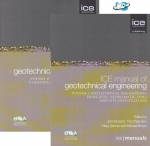Tab Article
Part of the ICE manuals series, ICE manual of geotechnical engineering is the definitive geotechnical reference, providing best practice knowledge for civil and structural engineers.
Good geotechnical engineering requires an appreciation of the balance between theoretical principles, practical experience and the uncertainties present when dealing with the ground in its natural state. Written and edited by leaders in their fields, ICE manual of geotechnical engineering addresses this need, delivering an authoritative, comprehensive reference for the core geotechnical engineering principles, practical techniques, and the major questions engineers should keep in mind when dealing with real-world engineering challenges.
Covering the key topics in geotechnical engineering, from fundamental principles through site investigation and design to construction processes and verification, including problematic soils, and the design of foundations, earthworks and retaining structures, ICE manual of geotechnical engineering is an essential guide and invaluable reference for practising civil and structural engineers, architects, designers, consultants and contractors, working on projects of all sizes.


